高中英语选修七教案:Unit4+Sharing+grammar+
- 格式:doc
- 大小:80.09 KB
- 文档页数:14
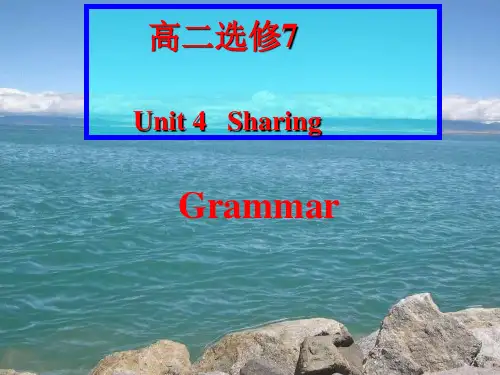
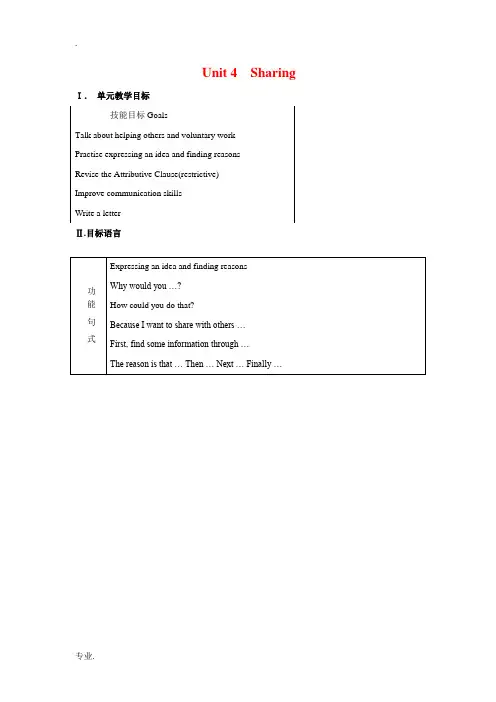
Unit 4 Sharing I.单元教学目标Ⅱ.目标语言III. 教材分析与教材重组1. 教材分析本单元以Sharing为话题,旨在通过单元教学,使学生了解世界上很多地方依然很落后,从而懂得同情,学会分享。
结合针对短文话题的探讨激发学生的国际意识,通过各种渠道力所能及地为贫困地区的孩子做出自己贡献。
1. 1 WARMING UP 提供了三项任务。
通过完成这些任务让学生懂得什么是“帮助〞,并且反思自己是否乐于助人,以及怎样做才是“志愿者〞,由此为后面的短文学习做好铺垫。
1. 2 PRE-READING是READING的热身活动。
其中介绍了短文主人公Jo,还根据她在PNG拍的照片提出了5个问题,使学生在阅读之前就简单了解短文内容。
1. 3 READING是一篇Jo写给Rosemary的信。
其中介绍Jo在PNG(Papua New Guinea)的所见所闻,使学生感受到PNG的儿童生活艰难,从而珍惜自己的学习机会。
.1. 4 COMPREHENDING 是根据短文设计的阅读理解试题。
1. 5 LEARNING ABOUT LANGUAGE分词汇和语法两部分。
其中,第一部分是有关此篇短文中的重点单词和短语;第二部分是有关限定性定语从句的复习。
1. 6 USING LANGUAGE是对READING的延伸。
通过阅读,参与“Give an unusual gift〞的活动。
1. 7 LISTENING AND SPEAKING通过Jennifer Wells的采访介绍了Mary Murray作为MSF的一个volunteer的工作经历,而且针对这一话题展开Speaking。
1. 8 WRITING 根据LISTENING AND SPEAKING话题运用时间表达方式进行写作。
2. 教材重组2.1 从话题内容和训练目的上分析,WARMING UP与LISTENING AND SPEAKING相一致;从教材份量来说,可将WARMING UP与LISTENING AND SPEAKING的1、2、3、4项和Workbook中的LISTENING以及LISTENING TASK整合在一起,设计成一节任务型“听力课〞。
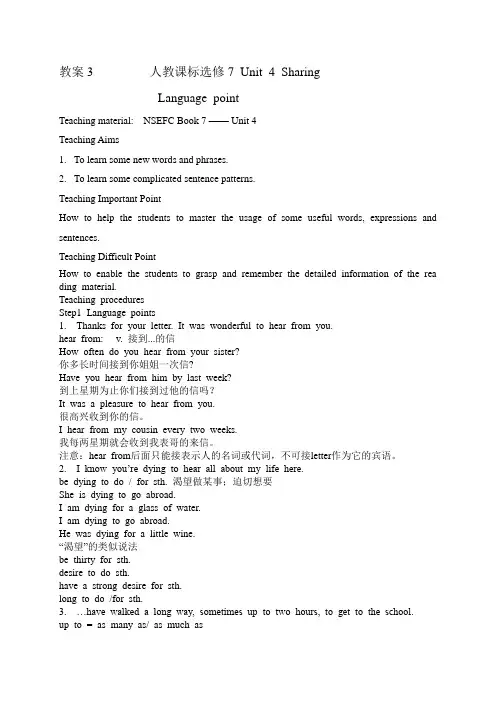
教案3 人教课标选修7 Unit 4 SharingLanguage pointTeaching material: NSEFC Book 7 —— Unit 4Teaching Aims1.To learn some new words and phrases.2.To learn some complicated sentence patterns.Teaching Important PointHow to help the students to master the usage of some useful words, expressions and sentences.Teaching Difficult PointHow to enable the students to grasp and remember the detailed information of the rea ding material.Teaching proceduresStep1 Language points1. Thanks for your letter. It was wonderful to hear from you.hear from: v. 接到...的信How often do you hear from your sister?你多长时间接到你姐姐一次信?Have you hear from him by last week?到上星期为止你们接到过他的信吗?It was a pleasure to hear from you.很高兴收到你的信。
I hear from my cousin every two weeks.我每两星期就会收到我表哥的来信。
注意:hear from后面只能接表示人的名词或代词,不可接letter作为它的宾语。
2. I know you’re dying to hear all about my life here.be dying to do / for sth. 渴望做某事;迫切想要She is dying to go abroad.I am dying for a glass of water.I am dying to go abroad.He was dying for a little wine.“渴望”的类似说法be thirty for sth.desire to do sth.have a strong desire for sth.long to do /for sth.3. …have walked a long way, sometimes up to two hours, to get to the school.up to = as many as/ as much asHe can earn up to $50,000 a year.up to 还可以表示1)be up to sth = be busy doing sth. 忙于2)It is up to sb to do sth 由某人负责做某事3)一直She lived at home right up to / until she got married.What are these naughty boys up to?It is up to me to do this task.I am not sure if she is really up to that job.4. I’m still trying to adapt to these conditions but, one thing is …adapt (oneself) to 适应,适合The new students are very slow to adapt to the rules.新生对于那些规定适应得很慢。
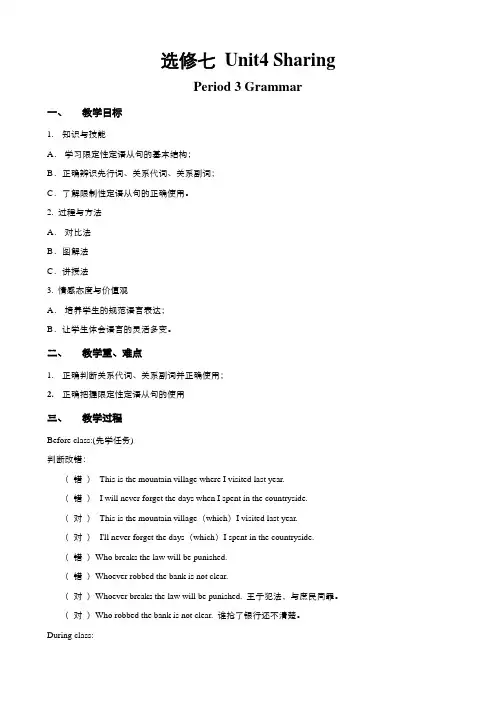
选修七Unit4 SharingPeriod 3 Grammar一、教学目标1.知识与技能A.学习限定性定语从句的基本结构;B.正确辨识先行词、关系代词、关系副词;C.了解限制性定语从句的正确使用。
2. 过程与方法A.对比法B.图解法C.讲授法3. 情感态度与价值观A.培养学生的规范语言表达;B.让学生体会语言的灵活多变。
二、教学重、难点1.正确判断关系代词、关系副词并正确使用;2.正确把握限定性定语从句的使用三、教学过程Before class:(先学任务)判断改错:(错)This is the mountain village where I visited last year.(错)I will never forget the days when I spent in the countryside.(对)This is the mountain village(which)I visited last year.(对)I'll never forget the days(which)I spent in the countryside.(错)Who breaks the law will be punished.(错)Whoever robbed the bank is not clear.(对)Whoever breaks the law will be punished. 王子犯法,与庶民同罪。
(对)Who robbed the bank is not clear. 谁抢了银行还不清楚。
During class:Step1: warming up & lead inCheck stud ents’ assignment and introduce what they will learn in this class.Translate the following sentences.正在打篮球的那个男人是科比。
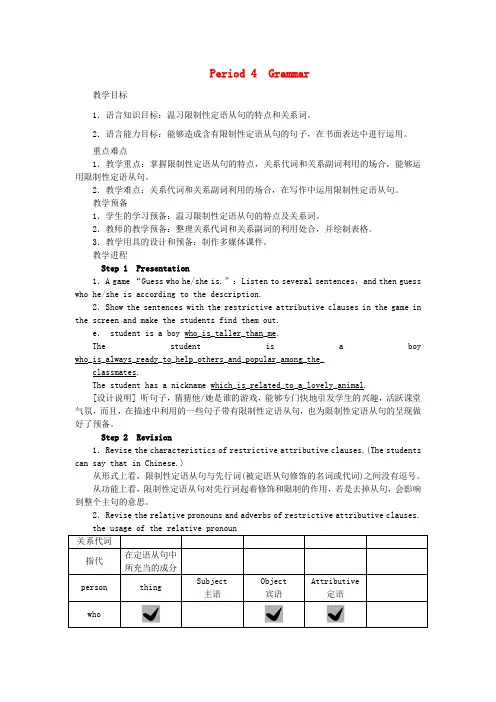
Period 4 Grammar教学目标1.语言知识目标:温习限制性定语从句的特点和关系词。
2.语言能力目标:能够造成含有限制性定语从句的句子,在书面表达中进行运用。
重点难点1.教学重点:掌握限制性定语从句的特点,关系代词和关系副词利用的场合,能够运用限制性定语从句。
2.教学难点:关系代词和关系副词利用的场合,在写作中运用限制性定语从句。
教学预备1.学生的学习预备:温习限制性定语从句的特点及关系词。
2.教师的教学预备:整理关系代词和关系副词的利用处合,并绘制表格。
3.教学用具的设计和预备:制作多媒体课件。
教学进程Step 1Presentation1.A game “Guess who he/she is.”:Listen to several sentences,and then guess who he/she is according to the description.2.Show the sentences with the restrictive attributive clauses in the game in the screen and make the students find them out.e. student is a boy who_is_taller_than_me.The student is a boy who_is_always_ready_to_help_others_and_popular_among_the_classmates.The student has a nickname which_is_related_to_a_lovely_animal.[设计说明] 听句子,猜猜他/她是谁的游戏,能够专门快地引发学生的兴趣,活跃课堂气氛,而且,在描述中利用的一些句子带有限制性定语从句,也为限制性定语从句的呈现做好了预备。
Step 2Revision1.Revise the characteristics of restrictive attributive clauses.(The students can say that in Chinese.)从形式上看,限制性定语从句与先行词(被定语从句修饰的名词或代词)之间没有逗号。
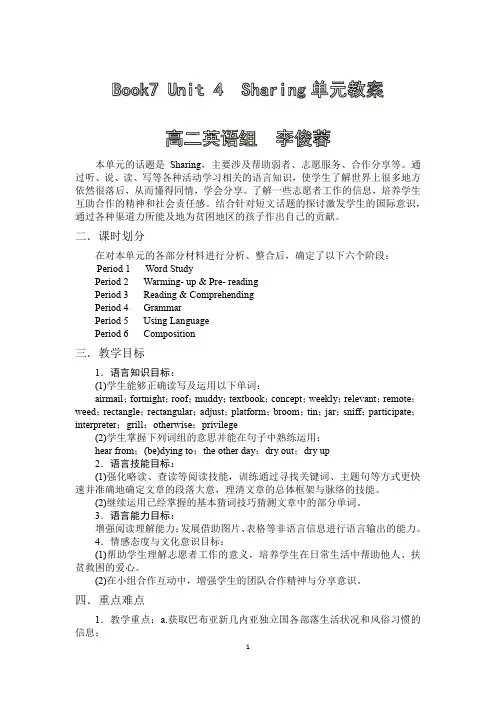
本单元的话题是Sharing,主要涉及帮助弱者、志愿服务、合作分享等。
通过听、说、读、写等各种活动学习相关的语言知识,使学生了解世界上很多地方依然很落后,从而懂得同情,学会分享。
了解一些志愿者工作的信息,培养学生互助合作的精神和社会责任感。
结合针对短文话题的探讨激发学生的国际意识,通过各种渠道力所能及地为贫困地区的孩子作出自己的贡献。
二.课时划分在对本单元的各部分材料进行分析、整合后,确定了以下六个阶段:Period 1 Word StudyPeriod 2 Warming- up & Pre- readingPeriod 3 Reading & ComprehendingPeriod 4 GrammarPeriod 5 Using LanguagePeriod 6 Composition三.教学目标1.语言知识目标:(1)学生能够正确读写及运用以下单词:airmail;fortnight;roof;muddy;textbook;concept;weekly;relevant;remote;weed;rectangle;rectangular;adjust;platform;broom;tin;jar;sniff;participate;interpreter;grill;otherwise;privilege(2)学生掌握下列词组的意思并能在句子中熟练运用:hear from;(be)dying to;the other day;dry out;dry up2.语言技能目标:(1)强化略读、查读等阅读技能,训练通过寻找关键词、主题句等方式更快速并准确地确定文章的段落大意,理清文章的总体框架与脉络的技能。
(2)继续运用已经掌握的基本猜词技巧猜测文章中的部分单词。
3.语言能力目标:增强阅读理解能力;发展借助图片、表格等非语言信息进行语言输出的能力。
4.情感态度与文化意识目标:(1)帮助学生理解志愿者工作的意义,培养学生在日常生活中帮助他人、扶贫救困的爱心。
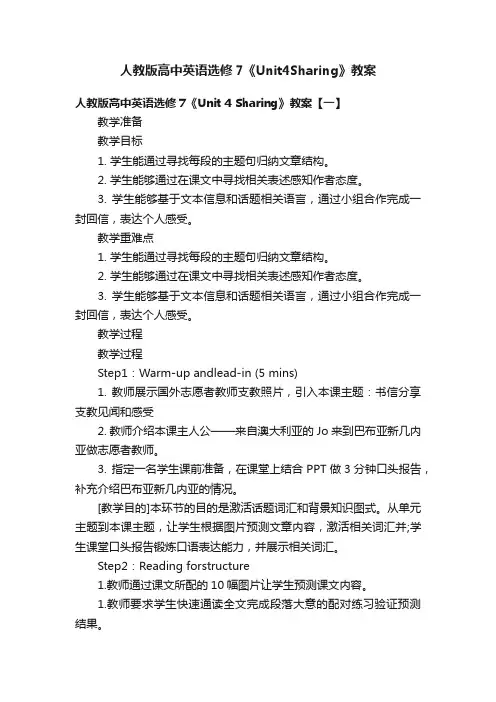
人教版高中英语选修7《Unit4Sharing》教案人教版高中英语选修7《Unit 4 Sharing》教案【一】教学准备教学目标1. 学生能通过寻找每段的主题句归纳文章结构。
2. 学生能够通过在课文中寻找相关表述感知作者态度。
3. 学生能够基于文本信息和话题相关语言,通过小组合作完成一封回信,表达个人感受。
教学重难点1. 学生能通过寻找每段的主题句归纳文章结构。
2. 学生能够通过在课文中寻找相关表述感知作者态度。
3. 学生能够基于文本信息和话题相关语言,通过小组合作完成一封回信,表达个人感受。
教学过程教学过程Step1:Warm-up andlead-in (5 mins)1. 教师展示国外志愿者教师支教照片,引入本课主题:书信分享支教见闻和感受2. 教师介绍本课主人公——来自澳大利亚的Jo来到巴布亚新几内亚做志愿者教师。
3. 指定一名学生课前准备,在课堂上结合PPT做3分钟口头报告,补充介绍巴布亚新几内亚的情况。
[教学目的]本环节的目的是激活话题词汇和背景知识图式。
从单元主题到本课主题,让学生根据图片预测文章内容,激活相关词汇并;学生课堂口头报告锻炼口语表达能力,并展示相关词汇。
Step2:Reading forstructure1.教师通过课文所配的10幅图片让学生预测课文内容。
1.教师要求学生快速通读全文完成段落大意的配对练习验证预测结果。
2.教师引导学生归纳出全文的整体结构。
[教学目的] 本环节的目的是让学生了解文章的整体结构。
不仅让学生学会寻找中心句,而且让学生从每个段落的中心句归纳出课文整体结构,让学生回顾信息交流类书信的写作结构。
Step3:Reading fordetails (10 minutes)1.教师要求学生先同桌配对合作,然后按照学习小组分组合作,仔细阅读文章细节找出信息,完成下列表格(划线部分是学生需要填出的部分):2.教师引导学生根据文章中的相关语言和信息体会作者的感情和态度。
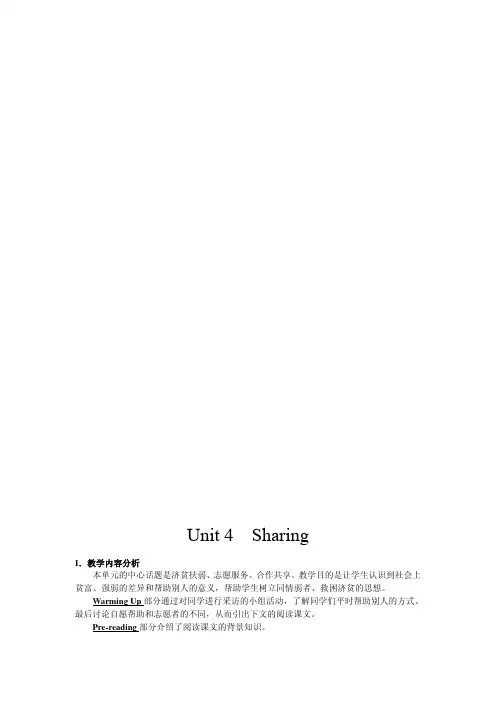
Unit 4 SharingI.教学内容分析本单元的中心话题是济贫扶弱、志愿服务、合作共享。
教学目的是让学生认识到社会上贫富、强弱的差异和帮助别人的意义,帮助学生树立同情弱者、救困济贫的思想。
Warming Up部分通过对同学进行采访的小组活动,了解同学们平时帮助别人的方式。
最后讨论自愿帮助和志愿者的不同,从而引出下文的阅读课文。
Pre-reading部分介绍了阅读课文的背景知识。
Reading部分是一封家书。
作者是一个到巴布亚新几内亚教书的志愿者。
文中介绍了巴布亚新几内亚农村的教育和生活状况,描述了到一个学生家做客的经历。
Comprehending部分设置了三个练习,目的在于让学生逐层加深对课文的理解。
Learning about Language部分突出了词汇和语法的学习与训练。
本单元的语法是复习限制性定语从句,特别是用that不用which的情况。
Using Language部分中包括了听、读、写三个部分的内容。
阅读部分介绍了一个出售特殊礼物、帮助发展中国家的网页。
听力部分通过记者对一个志愿者的采访,让学生更多地了解发展中国家,培养学生助人为乐的精神。
学习用时间表达法叙述事件是本听力练习的重点。
Summing Up部分要求学生对本单元所学的知识进行总结和评价,以找出不足之处,从而改进。
Learning Tip部分建议学生要积极参加小组活动,以练习口语,培养交际能力。
II.教学重点和难点1. 教学重点(1) 本单元的生词和短语;(2) 系统掌握运用限制性定语从句。
2. 教学难点(1) 认识帮助别人的重要性;(2) 学会发表评论和表达自己的看法;(3) 学会以时间为线索,叙述人物生平。
III.教学计划本单元建议分六课时:第一课时:Warming up, Pre-reading, Reading & Comprehending第二、三课时:Learning about Language第四课时:Reading and discussing (Using Language)第五课时:Listening and speaking (Using Language)第六课时:Reading task (Workbook), Speaking task (Workbook) & Writing task(Workbook)IV.教学步骤:Period 1 Warming up, Pre-reading, Reading & ComprehendingTeaching Goals:1. To help Ss to learn the importance of helping others and the ways to help others.2. To help Ss to learn about the educational and living conditions of some developing countries and develop their awareness of helping those in need.3. To teach how to use the new words and phrases in the text.Teaching Procedures:Step 1. Leading-in1. Lead Ss to the content of this unit. Teacher may say, “We have all heard about Lei Feng, who was ready to help others and set us an example. We live our own lives. Everybody has his own work to do. Why must we help others?”2. Get some Ss to present their opinions on the question above before the class.Suggested Answer:Nobody can do everything alone, no matter how powerful he is. Nobody never meets with trouble, no matter how well he is going. So everybody needs others’ help. But we cannot alwaysreceive but never give. We must give in return for what we receive. We give help because we have been helped. Since we were born, we have received a lot from the society. So we should return it. We give help today, but we may need help tomorrow. Even if we may not see a person again, by helping him, we can let him know help is necessary and important for those who are in need. By helping each other, people can feel that life is full of warmth and friendliness and is worth living. In a word, to help others is to help oneself.Step 2. Warming Up1. Ask Ss to discuss the following question.In what ways do we help the people around?2. Ask Ss to work in groups of four and one of them to interview the other three. Tell him to ask the questions in Ex1 of Warming Up on P28. Then get one pair to act out their dialogues before the class.3. Divide Ss into four groups and ask them to discuss the following question.Can we call the person who helps others a “volunteer”?Suggested Answer:When one of your parents or friends needs help, you may not be asked to help but you volunteer to help, we don’t say you are a volunteer. A volunteer is a person who helps others in or outside his community or in a foreign country.Step 3. Pre-readingPurpose: To get Ss prepared for the reading text.1.Ask Ss to look at the pictures on P29~P30 and guess what the passage talks about.2.Ask Ss to describe the students and their classrooms in the pictures. After that, let Ss imaginetheir living conditions.3. Lead Ss to the reading text. Teacher may say, “Today we are going to read a letter written by an Australian volunteer, Jo, who taught for two years in Papua New Guinea, a country to the south of Australia.”Step 4. SkimmingPurpose: To help Ss get the general idea of the letter.1.Ask Ss to listen to the tape and try to get the main idea of the text.Suggested Answer:In the letter, the writer wrote about the educational and living conditions in PNG and her experience of visiting a student’s village.2.Play the tape paragraph by paragraph and let Ss read after it. Then ask them to sum up themain idea of each paragraph with only one sentence.Suggested Answer:Para.2: The school is simply built and far away from the students’ homes.Para.3: The educational conditions are very poor.Para.4: I visited a village of one of my student’ and received a warm welcome.Para.5: I stayed with the student’s family and their huts were poorly equipped.Para.6: I had a meal with the student’s family and they cooked in an unusual way.Para.7: I returned from the visit and felt greatly rewarded.Step 5. ScanningPurpose: To help Ss get a deeper understanding of the text..1. Ask Ss to find out the relationship of the people mentioned in the text. Teacher may say, “There are some persons mentioned in the text. Can you name them? Can you find out who they are?” Suggested Answers:Jo — the writer of the letter.Rosemary — the person who Jo is writing to.Tombe — one of the writer’s boy students, whose family Jo visitedJenny — the writer’s fellow workerKiak — Tombe’s motherMukap — Tombe’s father2. Ask Ss to read the text carefully and ask them the following questions. It is better to read them out to Ss than to present them on the blackboard. Encourage Ss to keep the eyes away from the books when they answer the questions.(1)What is the school like?(2)Is the writer popular with her students? How do you know?(3)What is the writer’s difficulty in teaching?(4)Why did the students jump out of the windows?(5)Why does the writer wonder if she is making any difference to her students’ lives?(6)Was the writer warmly welcomed by the villagers? How do you know?(7)Do Mukap and Kiak usually sleep in the same house?(8)Where did the writer and Jenny sleep that night?(9)Why did Tombe throw away the tin can?Suggested Answers:(1)It is made of bamboo and the roofs are made of grass. It is from away from Ss’ homes.(2)Yes. When she gets to school, the students all say hello to her.(3)There is no electricity or water and they have no textbooks. There is no teachingequipment.(4)Because they had never seen such an accident and were frightened.(5)Because most of her students will go back to their villages to work in the field and shethought what they have learnt will be of no use.(6)Yes. Because Tmbe’s mother welcomed her by crying “ieee ieee” and the villager allshook hands with her warmly.(7)No. They sleep in their own huts.(8)They slept on a newly-made platform in Mukap’s hut.(9)Because they think throwing away the tin can is in fact throwing away evil spirits.Step 6. Language point1. Ask Ss to work in pairs and underline and translate the following phrases in the text.hear from, be dying to do sth., up to, adapt to, the other day, before I knew it, come across, make a difference to sb., get to know, shake hands with sb., stick out of, get through, a newly made platform, a couple of, build a fire, leave…to do sth., dry out, dry up, fall into bed2. Lead Ss to deal with some more language points.(1) be dying to do sth (line 2, para1): want very much to do sth, have a strong desire to do sth.I am dying to know what has happened. 我迫切想知道发生了什么。

人教版高二英语选修7Unit4Sharing全单元教案人教版高二英语选修7 Unit 4 Sharing 全单元教案Warming-up and ReadingTeaching Goal:1. Target languagevolunteer, hear from, be dying to, come across, relevant, stick out, doorway, adjust, platform, soft, softly, grill, dry out, dry up, privilege, arrangement2. Ability goalEnable Ss to learn about PNG and Jo’s work in PNG as a volunteer teacher3. Learning ability goalHelp the Ss lean how to read between lines and find the positive and negative aspects of doing somethingTeaching methods:Discussion, skimming, scanning and task-based methodTeaching AidA recorder, a projector and PPT.Teaching Procedures:Step 1 Warming-upHave you ever helped others? What did you do to help your parents or other relatives? Or your friends? Or people outside your community? I am sure you’ve a lot to say. OK, now et into gurops and finish the survey form onP28.Step 2 Pre-readingAsk Ss to find out PNG on the map and disucuss the photos in the reading passage.Step3 Reading1. ScanningScanning the text and fill the blanks with their names.1._____ is a young Australian woman.2.________ was dying to hear all about Jo’s life in PNG.3._______ walked a long way to get to school.4.___________ didn’t have any textbook.5._____ became a lot more imaginative when teaching.6._____ started jumping out the windows during achemistry experiment.7.________ visited a village that was the home of one the boys, Tombe.8._____ started crying “ieee ieee” to welcome them.9._____ led us to a low bamboo hut.10._____ was going to share the platform with Jenny and Jo.11.________ softly talked to each other in their language Jodidn’t understand2. Skimming the text and find the general idea of each paragraph.3.detailed reading Task-based (ex1 in comprehending part.Type of houseFamily relation-shipsCooking methodsSleeping arrange-mentsType of houseFamily relation-shipsCooking methodsSleeping arrange-mentsStep IV.HomeworkSuppose you've graduated from a key university and now you are a volunteer who works in the remote region to assit thebasic education there. And you are to write a letter home to introduce your present situation. (you can refer to the text).Extensive ReadingTeaching goals:1. Enable the Ss to know the purpose of a website called “world gifts” and give their opinions on it.2. Enable the Ss to learn about the international welfare programmer called “Plan International” and a child who has been sponsored through it.Teaching important and difficult points:Get the Ss to realize that they should make the most of what they own and do something for the poor.Teaching method:Task-based method and fast readingTeaching aids:A recorder, a projector, a compute connected to the Internet.Teaching procedures:Step I.RevisionDictation eight sentences, each contain the vocabulary they ‘ve learned in this unit.Step II. Pre-reading“Have you ever tried to send a gift to the children in poor areas or countries? Probably not. Today, we can have access to a website, where you can send your gifts to those who are in great need. Please glance quickly at the Internet page on Page 33, and answer the following questions.1. What does the page show you?2. Where is the list of gifts?3. In what kind of order are the gifts listed? How much are cheapest and dearest gift?4. where is the gift card?5. What do the photos show you?Step III. Careful ReadingReading carefully.And the task is to finish Ex2 on page 34.Discussing What do you think of this website and its idea? Do you think people will get interested in it and buy its gifts? Do you think those gifts listed are really helpful? Now turn to page 34. Discuss the topics in Ex 3 in groups. Choose one of the topics to discuss.Step IV. Reading TaskDeal with reading task in the work book.We have talked about the Chinese welfare programmer Project Hope which helps children in poor areas go back to school. In the world, there are many organizations or programmers that help different groups of people in one way or another. Today, we will get to know another organization called Plan International. Turn to page 73,. This is a letter from Rosanna to some students. Rosanna works as a volunteer of Plan International in an area of Ecuador. Why did she write to the Ss? What did the Ss do? Read the letter and find the answers. While reading, summarize the topic of each paragraph and finish Ex on page74.Step V. Homework1. Ask Ss to search for information about Plan International.2. Pick out the sentences with attributive clauses in “ A letter from Plan”.WritingTeaching Goal:Enable the Ss to write about a person’s experience by usingtime expression_r_rEnable the Ss to write a letter to a child they would like to sponsor Teaching important and difficult pointsThe characteristics of narrationTeaching methods:Task-based methodTeaching AidA projector and PPT.Teaching Procedures:Step 1 RevisionCheck the homeworkAsk some Ss to read sentences w ith attributive clauses in “ A letter from plan”.Step 2 Pre-writingLet’s recall something about Dr Mary Murray, who worked as a volunteer with Medicines Sans Frontiers (MSF). Who’d like to say something about her? Let’s try it this way. Each of you is gi ven the chance to say only one sentence about Dr Mary Murray. OK, begin. Of course, you can have an attributive clause in your sentenceDr Mary Murray was a volunteer, who worked with Medicines Sans Frontiers (MSF).Dr Mary Murray once worked in clinic in both Malawi and Sudan which are developing countries in AfricaStep 3 WritingVery good. Now you are asked to write about Dr Murray for the school magazine. Write a paragraph on each topic below in the order shown. Remember to use time expression_r_rs listed on Page 35.Points must be included:1. who she is2. reasons why she joined MSF3. what she did in Malawi4. what she did in the Sudan5. the effects on her of her experiences.6. her plans for the futureStep 4 Writing taskDeal with writing task on Page75.Imagine that you have decided to sponsor Shanshan, a 11-year-old girl from Gansu province. Her family cannot afford to keep her at school. But she loves practicing English. Write a letter to her in English. In your letter, you can:Introduce yourselfSay something about your interests and hobbiesDescribed your familyLet her know you want to make friend with her and her from herOther things you would like to tell her.After the Ss have finished writing, ask several of them to read their letters.Sample writing:Dear Shanshan,I’m a student of Guangzhou No.1 senior High School, Guangdong province. My English name is Steve, and I like English very much. Maybe I can help you to continue with your school.I go to school everyday except on Sundays. Every morning, we have four lessons, including P.E., arts, music. I like sports very much, especially football .Whenever I’m free I would play football with my classmates.I also enjoy reading English papers, which gives me greatdelight, and helps improve my studies.I have a small family. There are father, mother and I. Mum often cooks delicious food for me. And Dad usually encourages me to study hard in order to serve the country and people better.I think so. So I work very hard at my lessons.I’m looking forward to hearing from you. I want to know what you need badly so that I know what I can do fro you .Don’t hesitate to ask for what you want. I will try to help you YourssincerelySteveStep 5 AssignmentAsk Ss to polish the letter they wrote in class and hand it in tomorrow.。
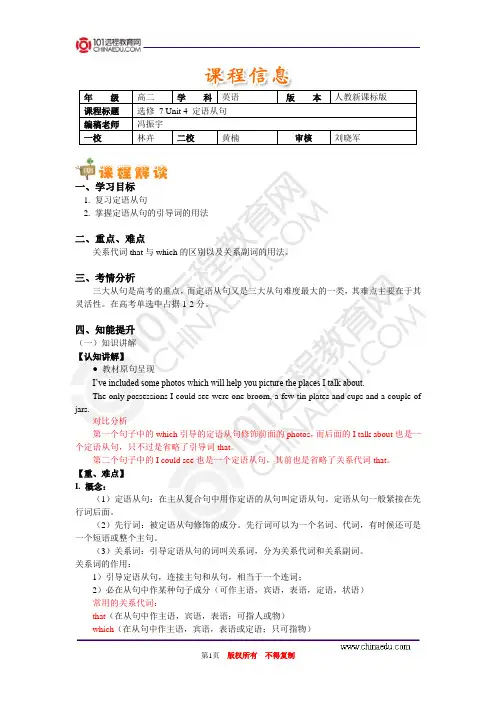
年级高二学科英语版本人教新课标版课程标题选修7 Unit 4 定语从句编稿老师冯振宇一校林卉二校黄楠审核刘晓军一、学习目标1. 复习定语从句2. 掌握定语从句的引导词的用法二、重点、难点关系代词that与which的区别以及关系副词的用法。
三、考情分析三大从句是高考的重点,而定语从句又是三大从句难度最大的一类,其难点主要在于其灵活性。
在高考单选中占据1-2分。
四、知能提升(一)知识讲解【认知讲解】● 教材原句呈现I’ve included some photos which will help you picture the places I talk about.The only possessions I could see were one broom, a few tin plates and cups and a couple of jars.对比分析第一个句子中的which引导的定语从句修饰前面的photos,而后面的I talk about也是一个定语从句,只不过是省略了引导词that。
第二个句子中的I could see也是一个定语从句,其前也是省略了关系代词that。
【重、难点】I. 概念:(1)定语从句:在主从复合句中用作定语的从句叫定语从句。
定语从句一般紧接在先行词后面。
(2)先行词:被定语从句修饰的成分。
先行词可以为一个名词、代词,有时候还可是一个短语或整个主句。
(3)关系词:引导定语从句的词叫关系词,分为关系代词和关系副词。
关系词的作用:1)引导定语从句,连接主句和从句,相当于一个连词;2)必在从句中作某种句子成分(可作主语,宾语,表语,定语,状语)常用的关系代词:that(在从句中作主语,宾语,表语;可指人或物)which(在从句中作主语,宾语,表语或定语;只可指物)who(主格,在从句中作主语,在口语或非正式用法中可作宾语;只可指人)whom(宾格,在从句中作宾语;只可指人)whose(属格,在从句中作定语,可指人或物)as(在从句中作主语,宾语,表语;可指人或物,通常指代事物);常用的关系副词(在从句中只作状语):when(时间状语),why(原因状语),where(地点状语)II. 几个关系代词的基本用法:一)that:①可指人或物;②在定语从句中作主语,宾语,表语(指人时,相当于who或whom;指物时,相当于which);③一般不用于非限制性定语从句;④不可置于介词后作宾语。
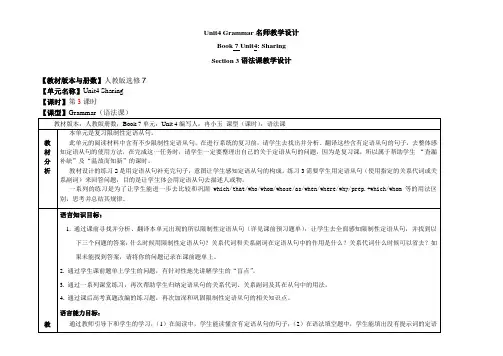
2019学年度人教版选修七Unit Four SharingPeriodPeriod4 Grammar教案教学目标1. 语言知识目标: 复习限制性定语从句的特点和关系词.2. 语言能力目标: 能够造含有定语从句的句子.教学重难点:1. 重点: 掌握限制性定语从句的特点, 关系代词和关系副词的使用场合, 能够运用限制性定语从句.2. 难点: 关系代词和关系副词使用的场合, 并能在写作题中正确运用.Step 1 PresentationPresent students some examples to lead to the new text.1) The student is a boy who is taller than me.2) The student is a boy who is always ready to help others and popular among the classmates.3) The student has a nickname which is related to a lovely animal.Step 2 Revision复习限制性定语从句语法基础: 在句子中起定语作用, 修饰句子中名词或代词的从句, 被修饰的名词或代词叫先行词; 引导定语从句的词叫引导词. 关系词有关系代词(that, which, who, whom, whose, as等)或关系副词(where, when, why等).一. 关系代词引导的定语从句The man who I just talked to is our headmaster.The person (whom) you met on the bus is Mr Zhang.He is the man whom / who I saw yesterday.Football is a game which is liked by most boys.This is the car (which) he bought yesterday.A plane is a machine that / which can fly.The man that / who is standing there is his father.A child whose parents are dead is called an orphan.I’d like a room whose window faces south.The classroom whose door is broken will soon be repaired.= The classroom the door of which is broken will soon be repaired.As也可作关系代词, 常用于下列结构: as……as, so….as, such….as, the same….as.I have the same watch as (have).I have never heard such an interesting story as he tells.二. “介词+ 关系代词”引导的定语从句The school (that / =which) he once studied in is very famous.= The school in which he once studied is very famous.Tomorrow I will bring here a magazine (that / which) you asked for.= Tomorrow I will bring here a magazine for which you asked.含有介词的动词短语一般不拆开使用, 如look for; look after; take care of等.This is the watch which / that I am looking for.若介词放在关系代词前, 关系代词指人时用whom, 不可用who或者that; 指物时用which, 不能用that; 关系代词是所有格时用whose.The man with whom you talked is my friend. (T)The man who / that you talked with is my friend. (F)三. 关系副词引导的定语从句I still remember the day when I met her for the first time.The time when we got together finally came.Wuhan is the city where I was born.The house where I lived ten years ago has been pulled down.I don’t know the reason why he was late today.Please tell me the reason why you missed the plane.The reason why / for which he refused the invitation is not clear.This is the house where / in which he lived last year.I will never forget the day when / on which you came to see me.语法延伸:一. 限制性定语从句只能用that的几种情况:1. 当先行词是anything, everything, nothing, few, all, none, much, some (something除外)等不定代词时, 或者是由every, any, all, some, no, little, few, much等修饰时.All that can be done has been done. 所有能做的都已经做了.Have you taken down everything that Mary has said?All the things that you told me are lies. 你告诉我的全都是谎言.2. 当先行词被序数词修饰时.The first place that they visited in London was the Big Ben.3. 当先行词被形容词最高级修饰时.This is the most beautiful city (that) I’ve ever been to.4.当形容词被the very, the only修饰时.This is the very dictionary that I want to buy.He is the only man that can solve the problem.5. 当先行词前面有who, which等疑问词时.Who is the man that is standing there?Which is the T-shirt that fits me most?6. 当先行词既有人又有物时.They talked about things and persons that they remembered.二. 定语从句和同位语从句的区别:1. 定语从句修饰或限定先行词, 先行词可指人或物等, 为修饰关系; 同位语从句对名词作补充说明, 说明该名词的具体内容, 这个名词多是抽象名词, 如belief, doubt, fact, idea, news, possibility, opinion, report, truth, wish, information, conclusion等. 定语从句的关系代词可以省略, 而同位语从句中的连接词不能省略.2. 区别宾语从句与同位语从句的具体办法是: 在that从句前加is, 如果句子仍然成立就是同位语从句, 因为同位语从句对主导名词的内容起解释说明的作用; 而加上is句子不成立的就是定语从句, 因为定语从句与先行词是修饰关系.The suggestion that he had made is that the meeting be put off.The suggestion that the meeting be put off proved right.The news that he wants to get is whether he will be sent to the countryside.The whole truth came out at last that he was a wolf in sheep’s clothing.真相终于大白了, 他原来是只披着羊皮的狼.补充练习:1. Children who are not active or _____ diet is high in fat will gain weight quickly. A. what B. whose C. whichD. that2. I’ve become good friends with several of the students in my school ______ I met in the English speech contest last year.A. whoB. whereC. whenD. which3. ----Can you believe I had to pay 30 dollars for a haircut?----- You should try, the barber’s ______ I go. It’s only 15.A. asB. whichC. whereD. that4. That’s the new machine ______ parts are too small to be seen.A. thatB. whichC. whoseD. what5. The newly-built café, the walls of _____ are painted lightgreen, is really a peaceful place for us, especially after hard work.A. thatB. itC. whatD. which6. The girl arranged to have piano lessons at the training center with her sister _____ she would stay for an hour.A. whereB. whoC. whichD. what7. Duty is an act or a course of action that people _____ you to take by social customs, law or religionA. persuadeB. requestC. instructD. expect8. Jenny was looking for a seat when, luckily, a man _____ and leftA. took upB. got upC. shut upD. set up9. So far we have done a lot to build a low-carbon economy, but it is _____ ideal. We have to work still harder.A. next toB. far fromC. out ofD. due to10. In our class, when the bell rang and the teacher closed his book, it was a _____ for everyone to stand up.A. signalB. chanceC. markD. measure11. ---May I have a talk with one of your sports reporters?-----Sorry, but they are all out to _____ the main events of the day.A. getB. findC. coverD. search12. You told me that you did it by yourself, but I heard this was not the _____.A. thingB. caseC. conditionD. situation13. Some people can never go above 4,000 meters, because their body is unable to _____ these extreme conditions.A. belong toB. apply toC. adapt toD. contribute to14. He is a famous pianist; it’s a(n) ______ to hear him play.A. favorB. advantageC. possibilityD. privilege15. Nuclear science should be developed to _____ the peoplerather than harm them.。
Unit 4 SharingGrammar教学案教学目标知识内容复习限制性定语从句的特点和关系词。
等级水平(A)识记(B)理解(C)应用(D)分析(E)综合(F)评价能力目标通过练习,掌握限制性定语从句。
过程与方法预习语法---小组讨论--- 小组归纳---巩固训练情感态度与价值观学生需要在不同情景中运用定语从句教学设计重点难点分析引导学生复习定语从句用法与功能,发现和填补知识漏洞。
教学技术设备The multi-media教学环节学习目标(1)复习限制性定语从句的基本用法。
(2)提高学生在不同地情景中运用定语从句的能力。
(3)培养学生猜测能力以及积极合作的意识和相互竞争的能力。
课题概述复习限制性定语从句,目的不是解决定语从句“是什么”,而是“怎么用”的问题,因而不适合采用传统语法课以教师为主,讲述-操练的单调做法,而应侧重语法的运用,做到“活”与“实”相结合。
教学环节分析讲解学生活动设计Step 1: Basic structure revision先行词+ 关系词+ 从句[设计说明]先行词(物) 先行词(人) 定语时间状语地点状语原因状语主宾主宾关系代词which √√that √√√√who √√whom √whose √关系副词when √where √why √此环节以公式和表格形式测试学生对定语从句基本结构的熟悉情况,简单明了,有利于快速激活学生已有的知识。
Step 2: Riddle competition & function教师将学生分成若干小组,并进行以下谜语竞猜活动:⑴Raise a question and ask the Ss to guess who they are? The question is as followed: They are kind and warm-hearted people who can give time,energy and talents to help others in need and serve their communities,expecting nothing in return. (Key: volunteers)⑵Presenting some pictures on the screen,ask the Ss to look at the given riddles and try to choose the best answers as quickly as they can.①He is the famous player who has become one of the volunteers of China Bone Marrow Bank.②He was the singer whose money was completely spent in sponsoring(资助)poor children to go to school.③This is the volunteer sign which/that is designed for the 29th Beijing Olympic Games.④It is one part of our country where lots of graduators are willing to go and help poor people.⑤I can well remember the date when the Chinese Young V olunteers Association was founded.⑶Get the Ss to recall the significant function of attributive clause —— It can modify nouns or pronouns including giving a definition of a word and describing sth. / sb.[设计说明]这环节里笔者利用生动有趣的谜语竞猜游戏,调动课堂活跃气氛。
Unit 4 SharingPeriod 1 warming up 教案I.Teaching aims:• 1. Guess what is “sharing”.• 2.Give the defination of “volunteer”.• 3.Enable the ss to do something for others.• 4.Describe something about the ten photos.II.Procedures:Step1. ThingkingWhat’s your un derstanding of sharing?Sharing is smiling.Sharing is helping.Sharing is enjoying.Sharing is understanding.Sharing is perfectingShare: to have, use ,pay, or take part in something with others among a group rather than singly.1. Children should be told to share their toys.2. We share the cost of the meal.3. We all share the responsibility for these terrible events.4. It’s always better to share your worries and problems.Step2. Free talk:Have you ever helped others? What did you do to help your parents? Or other relatives? Or your friends? Or people in your community? Or people outside your community?Step3. Give pictures and guess what is “volunteer”and what volunteers do.1)fight against the flood and rescue the old and the sick2)plant trees and protect our environment3)help the disabled4)clean the community5)Teach the kids in the mountainous areasStep 4. Discuss:What can we do for the following people?Money/quilt/ medicine/food/bloodStep5. Give the definition of “volunteer”.People who help others in their community or outside their community would be called volunteers. However, they would not be called volunteers if they help their parents, other relatives or friends. The important factors1)not for rewards – esp. money and materials2)Volunteer – not forced to do so3)Not only the person but also the society and the environment benefit from it.4)with participationStep 6. Discuss task:What voluntary work have you done? If not, what will you volunteer to do in the future?Which countries do you think need help most? Why?In which country do you want to do voluntary work? In China or abroad? Why?Step7. Pre-reading(to learn something about Papua New Guinea)What do you know about Papua New Guinea?There are many volunteers working in different mountainous areas or developing countries, amongwhich Papua New Guinea(PNG) is one.Location: situated to the north of AustraliaPopulation: about 5.7 millionLanguage: English as the official languagePidgin English as the language for communicationEconomy: a poor country with most people living in tribal villages and depending on subsistence farming to make a living.Education: About 85% of children start school but only about 60% of these reach Year 5Step8. Give a brief description of the photos:Jo was a volunteer worked in Papua New Guinea (PNG) for two years.The following photos were taken by Jo in PNG. Look at the photos and answer the questions. Photos 1---31.What kind of student was in Jo’s class?Poorly dressed teenage boys2.Describe the classrooms.wooden pools, bamboo walls, grass roofs, grass on the floor, no glass in the windows3. What similarities and differences can you find between Jo’s and yours?Similarities: In a room with groupsdifferences: Jo’s classroom made of bamboo with grass roof and no windowsOurs made of bricks with glass windowsPhotos 4---101.What can you say about the village?The village is small. It’s by a river at the bottom of a valley. It has steep slopes all around it.2.What can you say about life in the village?The village huts are small. They have no widows and are made of wood, bamboo, and grass. The main crop is peanuts. The tool for planting is a digging stick. There is a bare-footed woman carrying a naked baby and a heavy bag on her shoulders.Step9. Homework:Ask Ss to work in groups and talk about the donations. If possible, encourage them to do for the poor children in poor areas in our country or in other countries.Unit4 SharingPeriod Two Reading教案I. Teaching aims:1. Enable t he Ss to learn more information about Jo’s job and the conditions of her teaching.2. Know more about the customs of local people.3. Discuss how you would do if you were a volunteer working in that area.4. Get more reading skills.II. Teaching procedure:Step 1: pre-reading:Give two questions:What was Jo’s job in PNG?What kind of students were in her class?Step2: Fast reading1. Jo is a young Australian women.2.Rosemary was dying to hear all about Jo’s life in Papua New Guinea.3. The boys walked a long way to get to the school.4. The boys and Jo didn’t have any textbooks.5. Jo became a lot more imaginative when teaching.6. The boys started jumping out the windows during a chemistry experiment.7. Jenny and Jo visited a village that was the home of one of the boys, Tombe.8. Kiak started crying “ieee ieee” to welcome them9. Mucap led us to a low bamboo hut.10. Kiak was going to share the platform with Jenny and Jo.11. Tombe’s family softly talked to each other in their language Jo didn’t understa nd.Step3. Do the judgement. (True or false according to the text)1. The classrooms are made of bricks and the roofs of grass.(F)2. It always takes the boys only a few minutes to get to the school.(F)3. Science is the most challenging subject for Jo.(T)4. When Jo and Jenny arrived at the village,they shook hands with all the villagers.(T)5. Tombe threw out the tin can because it’s very dirty.(F)Step4. Skimming and then answer the following questions:1.Why did Jo send Rosemary some photos?It’s difficult for Rosemary to imagine how life was hard / different in Jo’s ---2. Why was the high school called a bush school?The classroom were madeof bamboo and the roofs were made of grass.3. Were the boys and villagers friendly to Jo? How do you know?Lots of “good mornings” ; cry “ ieee ieee” ; shake hands4. Why was Science the most challenging subject for Jo?There was no equipment.5. Why did the boys start jumping out the window?The boy never came across something like bubbling mixture6. Why should it take Jo and Jenny two and a half hours to get to the village?They had to climb up a mountain to a ridge first and then down a steep path to the valley. Step5. Scanning and then anylize the structure of the text.Try to give the right order according to the contents of the text.2A .The condition of the school.1B An introduction.4C. The endingA. We had a meal and I saw a strange custom.B. The experiment frightened the boys.C. I am glad to receive Rosemary’s letter and I’ve included some photos.D. I left and I felt privileged.E. I saw the poor condition of the room.F. It’s a bush school and the students live far away.Step6. Detailed readingRead paragraph 1-3 and finish the questions1.Why does Jo call the high school a “bush school”2.Were the boys friendly to Jo? How do you know?3.How long does it take the students to go to school?4.Why was science the most challenging subject for Jo?5.Why did the boys start jumping out of the windows?6.Why does Jo wonder how relevant chemistry is to the kids?Read paragraph 1-3 and finish the questions1.Why does Jo call the high school a “bush school”Because the classrooms are made from bamboo and the roofs from grass.2.Were the boys friendly to Jo? How do you know?There are a lot of “good mornings” for Jo from the boys.3.How long does it take the students to go to school?Sometimes up to 2 hours4.Why was science the most challenging subject for Jo?There was no equipment.5.Why did the boys start jumping out of the windows?The boys never came across anything like the bubbling mixture.6.Why does Jo wonder how relevant chemistry is to the kids?Because most of the boys will go back to their villages after year 8 and she thinks chemistry may make little difference to the kids’ life.Step7. ComprehendingWhat have you learned about the customs and lives of the people in Tombe’s village? Read Jo’sStep8. Post-readingGuess the reasons for the facts according to the Jo’s letter.1. The boys jumped out of the windows in the science lesson.In the science lesson the boys were frightened by what they saw --- the mixture was bubbling over everywhere, thinking that something terrible had happened, so they jumped out of the windows to escape from danger.2. Jo wondered how relevant chemistry was to the boys.Because most of the boys will go back to their village after studying in the school, and their knowledge of chemistry will prove useless, so Jo wondered how relevant chemistry was to the boys.3. Tombe’s mother cried “ieee ieee” when he say Jo.I think it’s a kind of greeting in their village. And I’m sure all the family members will be happy and excited to have visitors like Jenny and Jo.4. There were no windows in Mukap’s hut.There were no windows in Mukap’s hut. Perhaps in this way can prevent flies, mosquitoes and other insects from coming in. Of course, if there were glass, they could both have a big window, and at the same time, they can keep all the insects from entering.5. The tin can was standing upside down on the grill.The tin can was standing upside down on the grill in order to get the leftover dry up quickly.Step9. Fill in the chart:What do you think are the positive and negative things about living in a village in Papua NewStep10. Discussion in groups:think you would have felt? Give reasons.First I think it was such a long distance from the school to Tombe’s home. Second, the family members and the villagers showed great hospitality to us, which impressed us very deeply. Third, we got the chance to know the villager’s simple life. Therefore, we were determined to go on with volunteer work to help the boys get enough education3.Why do you think Jo became a volunteer in PNG? Give as many possible reasons as you can. Would you like to work as a volunteer in a poor area?Give reasons.Useful phrases: be willing to; do one’s bit to do; be eager to do; be full of ; work hard and endure hardship…Key words: kind-hearted; helpful; strong-mindedA sample of the discussions:A: I think, first of all, Jo was a kind-hearted woman, who is willing to help others. Second, she knew enough about the poor conditions in PNG and thought that she could help teach in the schools. IfI am given the chance, I will do whatever I can to help.B: In my opinion, Jo must have worked as a teacher in Australia, and she applied to become a volunteer abroad, and then she was sent to PNG as a volunteer.C: Maybe she thinks that education is the key to solving all the problems in PNG, so she, as a teacher, goes to PNG to help.D: Perhaps she likes traveling abroad, helping the poor wherever she goes.E: I don’t agree with you. You know, she stayed there for two years. A traveler once d id that. She was willing to help the poor children in PNG to be educated. She was doing her bit to change thepoor’s state of living and education. Ifeveryone in the rich countries should do like her, all the problems stemming from poverty could be solved easily.F: I would like to say something about the second topic. I think I will be a volunteer in a poor area. Whenever I saw the poor living state of the poor in the western areas and mountainous areas, I was eager to do something for them. All are create d equal. But they can’t get what we can enjoy. What a pity! If possible, I will try to helpStep11.Homework:Surf the Internet to find some information about the volunteers working in poor areas.Unit 1 Living WellPeriod 3 Learning about language 教案I.Teaching aims:1. Guess words according to the word meaning.2. Fill in the blanks of a given passage.3. Learn important words , phrases and some important sentence stuctures.II.ProceduresStep 1 Do exercise for Ex.1 on page32Find words in the unit that have the following meanings.1.___to change slightly to make something work better (adjust)2 ____ a metal shelf for cooking meat, toasting bread, etc (grill)3 ____ connected with what is being done or discussed (relevant)4 ____ an idea(concept)5 ____ an honour(privilege)6 _____something that has been organized(arrangement )7. ____written work in an office, such as writingreports or letters(paperwork)8. ____ to breathe air into your nose noisily(sniff)Step2 Complete the paragraph with words or phrases below in their proper form.Sharon looked at herself in the mirror and sighed. She had posted the airmail letter to Tim last week but had had no reply.She smoothed her hair down with a wet comb, wiped her muddy shoes, and thought about the three months she had known her. He was the nicest boy she had ever met. Otherwise she would not have fallen in love with him. She still remembered that he adjusted quickly when he heard she came from a remote village. At first she had heard from him every week but now she had not heard for a fortnight. Why? She had decided to find out. She walked down the platform to catch the train to New York feeling both excited. and nervous. She was dying to see him again but what if he didn't want to see her?Step3 Look at these definitions and make suitable phrasal verbs with the words in the right box. Then make a dialogue using each one.out; off; up; from; for; up; down; of; to1( dry out) to become complete dry.2(dry up) to become dry on the surface.3(dry off) to come to an end4(hear out) to listen to somebody till the end5(hear from) to receive a letter or a phone call from someone6(hear of )to have knowledge of sb/ sth7(be dying to ) to want to do something very much8(die out ) to disappear or stop existing completely9(die down ) to graduallyy get quieterStep4 Learn important words , phrases and some important sentence stuctures.1.It was wonderful to hear from you.hear from sb. = receive a letter from sb. 收到某人的信hear of ,hear from & hear aboutHave you heard from Charles recently?I never heard of a man with the name Tom.I have heard much about Beckham.2. I know you’re dying to hear all about my life here.be dying to do / for sth. 渴望做某事;迫切想要She is dying to go abroad.I am dying for a glass of water.“渴望”的类似说法be thirty for sth./ desire to do sth./ have a strong desire for sth./ long to do for sth.3. Many of them have walked a long way, sometimes up to two hours, to get to the school.up to = as many as/ as much asHe can earn up to $50,000 a year.up to 还可以表示(1) up until 一直She lived at home right up to / until she got married.(2) good enough for sth. 胜任I am not sure if she is really up to that job.(3)由……负责It’s up to her to decide whether or not to go on the course4. The boys who had never come across anything like this before started…..come across 偶然遇见/发现I came across some interesting books in the room.I came across an old friend I hadn’t seen for years.come about 发生This situation should never have come about.come along 进展How is your work come along?5. imaginative adj.富有想象力的,爱想象的an imaginative child/writerimaginary adj.想象中的,假想的imagine v.设想imaginable adj.可想象的image n.雕像,肖像imagination n.想象力a man of rich imagination词语辨析:Imaginative: showing new and exciting ideas富于想象力的;创新的We need imaginative people to put new energy into the team.Imaginary: existing only in your mind or imagination想象中的The story is wholly imaginary.imaginable:(与形容词最高级或与all,every连用,表示强调或概括)想象得到的;可想象的The house has the most beautiful views imaginable.6.Sometimes l wonder how relevant chemistry is to these students,most of whom will be going back to their villages after Year 8 anyway1)relevant 有关的;有实际重要性的(be relevant to sth./sb.)His age is not relevant to whether he is a good teacher.他的年龄与他是否是一位好老师无关。
人教版高中英语选修7教案Unit4Sharing人教版高中英语选修7教案Unit 4 Sharing Unit 4 Sharing一、语言要点I单元要点预览(旨在让同学整体了解本单元要点)词汇部分词语辨析1 iaginative/iaginable/iaginar2 dr up/dr ut3 ther ise/therefre/hever词形变化1 perate v 操作, 动手术peratr n 操作员, (电话)接线员,peratin n 运转, 操作, 实施2 dnate v 捐赠, 赠予dnatin n 捐赠品, 捐款, 贡献3 arrange v 安排, 排列, arrangeent n 排列, 安排4 adust v 调整, 调节adustable ad可调整的adustent n 调整, 调节, 调节器partiipate v 参与,分享, partiipant n 参与者, partiipatin n 分享, 参与重点单词1 adust vt≈vi调整;使适合2 partiipate vi参与;参加3 therise adv用别的方法;其他方面Adv ≈ n否则;不然4 arrangeent n安排;排列dnate vt捐赠6 purhase vt≈n买;购买7 distributin n分配;分发;分布状态8 relevant ad 有关的, 相应的9 perate v 操作, 运转, 开动, 起作用重点词组(be) ding t 极想;渴望the ther da 几天前sti ut 伸出in need 在困难中;在危急中重点句型1 hen I reah the shl grunds there are lts f “gd rning” fr e fr the bs2 u ased hether I’getting t n an lal peple3 The gift vers the st f exerise bs and textbs fr unit priar shls that perate inpr r rete villages重点语法限制性定语从句(见语法专题)II 词语辨析(旨在提供完形填空所需材料) 1) iaginative/iaginable/iaginar ad【解释】iaginative富有想象力的,创新的iaginable可想象得到的iaginar想象中的,虚构的【练习】选择iaginative/iaginable或iaginar并用其适当的形式填空1) Althugh the ain haraters in the nvel are s true t life, the are _______2) It’s _______ fr suh an _______ riter t reate _______ stries3) This is the nl slutin _________4) The faus pe as fr an ______ petes: 1) iaginar 2) iaginable; iaginative ; iaginar 3) iaginable 4) iaginative。
Section ⅣGrammar限制性定语从句1.(教材P29)I know you’re dying to hear all about my life here, so I’ve included some photos which will help you picture the places I talk about.2.(教材P29)The boys who had never come across anything like this before started jumping out of the windows.3.(教材P29)But last weekend another teacher, Jenny, and I did visit a village which is the home of one of the boys, Tombe.4.(教材P29)We walked for two and a half hours to get there—first up a mountain to a ridge from where we had fantastic views and then down a steep path to the valley below.1.定语从句是用来修饰某一名词或代词的从句。
定语从句一般置于被修饰的词之后,且有引导词引导。
被定语从句所修饰的名词或代词叫先行词。
2.引导定语从句的词叫关系词。
关系词分为关系代词和关系副词。
3.定语从句分为限制性定语从句和非限制性定语从句。
关系代词1.关系代词 who, whom 和whose关系代词先行词在从句中充当的成分who 人主语、宾语、表语whom 人宾语whose 人/物定语London this summer vacation. (作主语)我是李华,一名今年暑假在伦敦学习的中国高中生。
Unit 4 SharingPeriod 4 Grammar 教案I. Teaching aims:1. To learn the kinds of Atributive Clause.2. To learn the usage of who, whose; whom; which; that; how; when; why等。
3.Do some practice.II.ProceduresStep1. Find 5 sentences used attributive clauses from the text:1. I’ve included some photos which will help you picture the places Italk about.2. The boys who had never come across anything like this beforestarted jumping out of windows.3. Sometimes l wonder how relevant chemistry is to thesestudents,most of whom will be going back to their villages after Year 84. But last weekend another teacher, Jenny, and I did visit a villagewhich is the home of one of the boys, Tombe.5.When we arrived at the village, Tombe’s mother, Kiak, who hadbeen pulling weeds in the garden, started crying “Leee, leee”.Step2. What is attributive clause?在复合句中修饰名词或代词的从句叫做定语从句。
被修饰的名词或代词叫先行词。
引导定语从句的关系代词有:which, that, who, whom, whose. 引导英语从句的关系副词有;_____ where,when, how, why。
注:1. 介词提前时一般只用which和whom。
2. whose+名词=the+名词+of which/ of whom定语从句分类定语从句The Restrictive Attributive Clause限制性定语从句The Non-Restrictive Attributive Clause非限制性定语从句限定性定语从句与非限定性定语从句得区别:限定性定语从句是句中不可缺少的组成部分,主句和从句之间不用逗号隔开。
引导词:关系代词和关系副词,作宾语时一些关系代词可以省略非限定性定语从句是对主句先行词的补充说明,没有这种从句不影响主句意思完整.一般用逗号把主句和从句分开。
引导词:who, whom, whose, which, of which, when, where等,不用that,不能省略Step3.关系词的用法:(一)关系代词的用法:1、作主语用who, which和that, 如:He is the man who/that lives next door.The train which/that has just left is for Shenzhen.2、作宾语用whom, who, which, that, 如:The man (whom/who/that) we have just seen is a famous writer. Where is the book (which/that) I bought last week?注:在非正式文体中,关系代词作宾语时,用于指人的who whom, that 和用于指物的which和that通常可以省略;但在介词提前时,或在非限定性定语从句中,关系代词即使作宾语也不可省略。
3、作定语用whose, 如:(a) He is the man whose car was stolen last week.(b) It was a meeting whose importance I did not realize at that time. 注:“whose +名词中心词”这一结构在定语从句中既能作主语(如上a 句),又能作宾语(如上b句)。
whose 的先行词常用来指人,但有时也可以用来指具体事物或抽象概念,这时可以与of which结构互换,词序是:“名词+of which”,如:They came to a house whose back wall had broken down. (= the back wall of which)He’s written a book the name of which I’ve completely forgotten. (= whose name)4、作表语只用that ,它既可以指人,也可以指物,但时常省略。
He is no longer the man that he used to be.This is no longer the dirty place (that) it used to be.难点:as引导限定性定语从句,指代被the same, such, as, so 等修饰的名词Don’t talk about such things as you don’t understand.We’re facing the same problems as we did years ago.It is as pleasant a film as I have ever seen.Here is so big a stone as no one can lift.比较:Here is so big a stone that no one can lift it.(结果状语从句)宜用that引导的定语从句1)序数词或最高级形容词修饰先行词时,要用that。
The first English novel that I read was A Tale of Two Cities by Charles Dickens.2)all, everything, nothing, something, anything 等不定代词作先行词时用that。
Everything that we saw in the factory greatly interested us.3)人和物合作先行词时,要用that。
We were talking about the persons and things that we remembered in our school.4)先行词前有the only, the very, the right, the same等修饰时,要用that。
It is the very skirt that suits me well.5) 在疑问词who、which、what开头的句子中,要用thatWhoever that is content with a little progress can’t make big achievements.6) 关系代词在定语从句中作表语只用thatHe is no longer the man that he used to be.This is no longer the dirty place (that) it used to be.宜用which引导的定语从句1)当定语从句的介词提前时,要用which。
The house in which they lived last year has been rebuilt.2)引导非限制性定语从句时,要用which。
He bought a railway ticket for the woman, which helped her a lot.宜用as引导的定语从句1)先行词与such, the same连用或先行词本身就是the same, such时,要用as。
Such people as you describe are rare nowadays.Would you like to buy the same pen as I have?2) 代替整个句子,在从句中作主语,而从句位于句首时,要用as。
As is well known, the earth goes around the sun.宜用who引导的定语从句:当先行词是人称代词或是those, anyone等时,常用who。
He who does not reach the Great Wall is not a true man.Those who were either fools or unfit for their offices could not see the cloth.Step4(二)关系副词的用法:1、when 指时间,在从句中作时间状语,它的先行词通常有:time, day, morning, night, week, year 等。
如:I still remember the time when I first became a college student.Do you know the date when Lincoln was born?注:when时常可以省略,特别是在某些句型和某些时间状语中。
例如:Each time he came, he did his best to help us.But help never stopped coming from the day she fell ill.2、where指地点,在从句中作地点状语。
它的先行词通常有:place, spot, street, house, room, city, town, country等,如:This is the hotel where they are staying.I forget the house where the Smiths lived.注:where有时也可以省略。
如:This is the place (where) we met yesterday.3、why指原因或理由,它的先行词只有reason。
That is the reason why he is leaving so soon.注:why时常也可以省略。